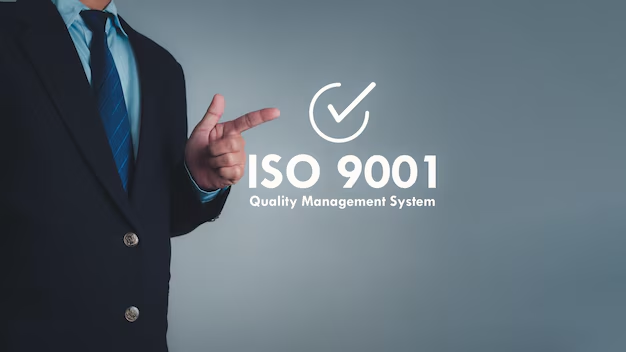What ISO 9001 Really Expects in Your Quality Control Plan?

ISO 9001 expects the right process approach. A Process Approach to ISO 9001 is a management style that promotes the plan-do-check-act cycle and risk-based thinking. It means that processes are governed and regulated. Therefore, a process approach to ISO 9001 should accomplish the goal of more predictable and consistent outcomes.
Why is the Process Approach so Important?
Organizations are usually divided into departments, each led by a department head. The department head is accountable for the output produced in their department. The majority of department heads are never involved with external customers, instead focusing on internal ones. Therefore, they are isolated from how the customer feels. This is what the ISO 9001 quality control plan offers to the organization. If individual departments can define the key performance indicators, this makes the situation worse. Organizational heads often prioritize their department performance, negatively impacting other downstream departments.
The ISO process approach promotes horizontal management, overseeing processes that span departmental boundaries. One person is accountable from start to finish. They possess the overall vision from process initiation to process conclusion. They understand what the process stakeholders require and are authorized to act to ensure that this occurs. The initial loyalty of an employee is to his or her projects, products or services assigned, not his or her departments.
What are the Most Important Differences Between Quality Assurance (QA) and Quality Control (QC)?
These Quality Assurance and Quality Control differences typically vary and are not always accurate, depending on the processes a firm employs and the firm’s size. These general differences shall be elaborated further in the following sections.
Here are some commonly cited differences between QA and QC-
- Proactive (QA) vs. Reactive (QC)- QA tends to be proactive, with emphasis on implementing processes and procedures, ensuring that things are done right to prevent issues before they occur. QC is reactive, where activities diagnose and repair issues in the product or service life cycle.
- Process Oriented (QA) vs. Product Oriented (QC)- QA is process-oriented and is focused on establishing and maintaining processes to ensure consistent product or service quality. QA activities include the establishment and implementation of Standard Operating Procedures (SOPs), auditing, and employee training. QC is product-oriented and consists of activities that test and analyze the quality of products or services. QC entails sampling, inspection, and testing to detect faults and ensure that the products meet proper quality requirements and specifications.
- System (QA) vs. Parts (QC)- QA is usually defined as system-based, with a focus on implementing and maintaining processes in order to assure overall product or service quality. QC is usually considered part-based, focusing on testing and inspection of individual products or units to detect and fix defects from established quality standards.
- Cross-Functional (QA) vs. Dedicated Staff (QC)– QA has often been defined as cross-functional, i.e., activities against all of a company’s products, services, and procedures. QC is generally associated with dedicated staff or teams that inspect, test, and verify the quality of specific products or components.
- Preventing (QA) versus Verifying, Controlling and Detecting (QC)- The generally accepted differentiation is that QA is focused primarily on preventing defects from occurring in the first place, while QC is focused on verifying and controlling quality by detection of defects in goods or services.
- Activities across Complete Lifecycle (QA) and Periodic Activities (QC)- The second commonly quoted distinction is that QA activities cover the entire lifecycle of a product or service, but QC performs periodic activities in the lifecycle.
- Managerial Tool (QA) and Operation Tool (QC)- QA is also called a managerial tool as it adheres to a systematic method of ensuring and improving the quality of products or services of a company. QA operations in managerial techniques can be such activities as strategic planning, policy-making, and reviewing quality periodically in an organization, among others. QC is regarded as an operating tool that is charged with the responsibility of certain tasks related to testing and controlling the quality of products or services. Activities of QC involve Statistical Process Control (SPC), sampling, product evaluation, and others for ensuring conformity of products to quality requirements and relevant standards.
Implementing a process approach to ISO 9001
The organization utilizes a process approach based on the Plan-Do-Check-Act (PDCA) cycle and risk-based thinking. This means that the organization must follow-
- Gaining Senior Management Commitment- Gaining the commitment and approval of senior management is the first and most important step. Inform them of the benefits of ISO 9001: higher efficiency at reduced cost, and customer satisfaction. Get their agreement to spend whatever resources are necessary for its implementation.
- Understand the requirements of ISO 9001- Familiarization with ISO 9000 and ISO 9001 standards is crucial for effective implementation. Principles such as customer focus, leadership, stakeholder involvement, management style, development, evidence-based decision making, and relationship management are such.
- Gap Analysis- Match what you currently do with the requirements of ISO 9001 and conduct a gap analysis. Secondly, identify areas of improvement in your organization. It is in planning this activity that you develop an action plan with roles and responsibilities to bridge these gaps.
- Quality Management System (QMS) Implementation- Establish a formal procedure for implementing your QMS. This shall include:
- Quality Manual- Place your cursor on “Insert” and click on “Blank Document” to create a document. Type in your quality policy and quality goals; describe the overall structure of your QMS.
- Procedures- Describe and document processes and controls.
- Forms and Records- Document tracking of the quality management system (QMS).
- Operational Planning and Control- Install the QMS by documenting policies, procedures, and targets. This includes:
- Operational Planning and Control: Plan processes and stay in control of them. Requirements Determination: Decide what the goods or services will be made up of.
- Design and Development: Products and services are designed and developed to specification.
- Follow-up delivery: outsourcing and service delivery management.
- Control of Nonconforming Outputs: Manage products and services that are not conforming.
- Measure and Monitor Performance- So your quality management system (QMS) is effective, by setting your Metrics and KPIs. Monitor periodically for measurement on:
- Process Performance: Record performance of process.
- Product and Service Quality: Outputs must meet consumer and regulatory demands.
- Internal audits: Conduct audits to identify areas of improvement.
- Seek Certification- If you have been operating the quality management system (QMS) for a few months, begin the certification. Your QMS will be checked for conformity to the requirements in ISO 9001 by the auditor. You’ll be certified with ISO 9001 if your company qualifies and the registration audit is successful.
- Permanent Improvement- ISO 9001 promotes permanent improvement. Use the results of monitoring and measurement to determine where improvement is necessary. Take corrective and preventative action to remedy current problems and improve the effectiveness of the QMS.
Conclusion
Implementation of ISO 9001, therefore, is a single important step toward improved performance and customer satisfaction in your organization. This step-by-step guide offers you everything necessary to plan an effective quality management system (QMS) with respect to ISO 9001 key performance indicators that bring continuous business improvement.




